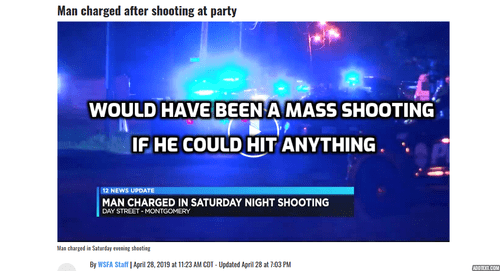
The Mass Shooting That Wasn’t, Because Blacks Don’t Shoot Very Well
06/02/2019
Here’s video of a shooting at an April birthday party in Montgomery, Alabama. [Language: NSFW]. I can’t count how many gunshots there were, but let’s just say: a lot.
But nobody was killed and only one person was wounded.
Note to the public: If you are going to risk your life to video a gunfight, turn your phone over sideways so you can film it in landscape mode.
From a 5 sentence story at WSFA:
According to Montgomery Police Captain Regina Duckett, Kennedy Wilson, 20, is charged with first-degree assault in connection with a shooting in the 1000 block of Day Street Road.
He’s the guy driving away in the minivan with the cop jogging after him. He got stuck in traffic and arrested.
You only get first-degree assault for starting a gunfight?
The victim suffered non-life threatening injuries.
Duckett said the investigation indicates the shooting happened during a party. Wilson was taken into custody at the scene.
So, this doesn’t qualify as a Mass Shooting. Multiple definitions of a Mass Shooting. The loosest requires 4 people be wounded. Stronger definitions require multiple deaths.
I post this to point out the distinction between two categories of Mass Shootings: what I call Suicide Shootings, in which the shooter intends to die or be sent to prison for a very long time, and Murder Shootings, in which the shooter intends to get away.
Suicide Shootings have higher average death tolls than Murder Shootings, which often have a high numbered of wounded. A key difference between Suicide and Murder shootings is the shooter hanging around to finish off the wounded.
Terrorism shootings are usually Suicide Shootings, but not always. The D.C. Snipers in 2002 might (or might not) be called terrorists, but they went to considerable trouble to get away. But they remain unusual.
Shooters with manifestos are almost always Suicide Shooters.
Gang members are usually Murder Shooters who intend to get away. On the other hand, some gang shootings might be Suicide Shootings.
Murder Shootings make up a sizable fraction of the general homicide rate and likely track up and down with the overall murder rate.
Suicide Shootings, however, did not start going up at the same time as the general murder rate in the mid-1960s, but lagged behind. They remained historically high while the general murder rate was falling in, say, 1994 to 2014. My guess is that they correlate more with suicide rates than with murder rates in time and in race.
